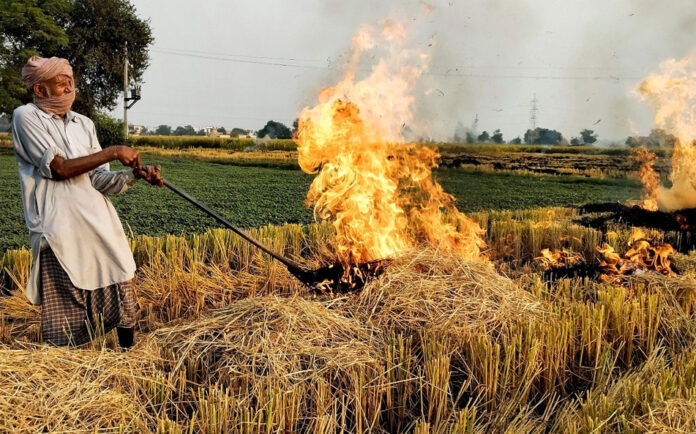CHANDIGARH:In a push to eliminate paddy stubble burning and curb the perennial air pollution crisis in the Delhi-National Capital Region (NCR) during winters, the Commission for Air Quality Management (CAQM) has rolled out a comprehensive strategy targeting zero farm fires in key paddy-sowing states of Punjab, Haryana, and Uttar Pradesh during the upcoming Kharif harvesting season.
The CAQM, formed to formulate air pollution control strategies for Delhi-NCR and adjoining areas, has recently issued two key directives instructing the states to establish a dedicated “Parali (residue) Protection Force,” mandate the use of paddy straw-based biomass pellets in brick kilns, and enhance monitoring and infrastructure development for effective crop residue management. These measures aim to address severe air quality deterioration caused by stubble burning, which is considered the key factor behind the smog affecting normal life in Delhi-NCR from November to February annually.
The CAQM’s 19-point action plan mandates Punjab, Haryana, and NCR districts of Uttar Pradesh to map every farm and devise tailored paddy stubble management strategies, including crop diversification, in-situ methods like mulching and decomposers, or ex-situ solutions such as baling and biomass utilisation. To ensure compliance, state-level committees headed by Chief Secretaries are required to submit monthly progress reports to CAQM starting June 1, supported by an online platform for realtime data reporting on crop residue management. Another key decision is the formation of the state-level “Parali Protection Force” at district and block levels.
The PPF will comprise police, agriculture, and administrative officers, who will intensify patrolling, especially during late evening hours, to counter farmers’ attempts to burn stubble under the cover of darkness to evade satellite detection. Sources in CAQM said there was a need to form the PPF because farmers often burn crop waste at night to avoid immediate action by officials.
A senior official from the Haryana State Pollution Control Board (HSPCB), speaking anonymously, said, “In several cases, we have noticed that farmers burn crop waste late in the evening. Even though satellites detect Active Fire Locations (AFL), farmers immediately plough the fields before officials arrive the next morning for physical verification. Now, the PPF will remain active round the clock and respond immediately when an AFL is detected.” Violators face strict penalties, including “red entries” in farm records, depriving them of government scheme benefits such as Minimum Support Price, along with environmental compensation charges.
CAQM has also directed the State Pollution Control Boards (SPCB) to involve the general public in live detection of stubble burning incidents by encouraging citizens to report such events via social media, enhancing community vigilance. The CAQM has also issued a landmark directive mandating brick kilns in non-NCR districts of Punjab and Haryana to co-fire paddy straw-based biomass pellets or briquettes starting November 1 to ensure the proper utilisation of millions of tonnes of paddy waste generated every year. The phased adoption plan targets a minimum of 20% paddy straw-based fuel usage by November 2025, scaling up to 50% by November 2028.
With approximately 940 brick kilns in non-NCR Haryana and 2,050 in Punjab, this initiative leverages the high fuel demand of these units to absorb significant quantities of paddy straw, reducing the need for open burning. This will also create a market for crop waste, providing an additional income source for farmers. The Central Pollution Control Board’s recent technical evaluation revealed that biomass pellets offer comparable calorific value to coal in zig-zag technology brick kilns, making them a viable and cleaner alternative.
Punjab, which generates around 19 million tonnes of paddy straw annually across 3.15 million hectares, and Haryana, producing 8.1 million tonnes, are poised to benefit from this ex-situ utilisation strategy. Farmers have welcomed this move, as it will help them manage crop waste more quickly and clear fields for the next sowing season as scheduled. However, there are hurdles in implementing these directions on the ground. Punjab currently has only 16 pellet manufacturing units, far below the capacity needed to meet demand from brick kilns and thermal power plants.
To address this, the Punjab government has allocated Rs 80 crore to subsidise in-situ machinery and Rs 300 crore for ex-situ initiatives, including new pellet plants. The CAQM has directed states to conduct a gap analysis of Crop Residue Management (CRM) machinery, discard outdated equipment, and procure new machines by August 31. Since most subsidised machines are owned by large farmers, strict directions have been issued to ensure small and marginal farmers access CRM machines rentfree through Custom Hiring Centres (CHCs).
Data from state agriculture departments reveal that Punjab has over 150,000 CRM machines supported by 24,736 CHCs, while Haryana has 90,945 machines backed by 6,794 CHCs, but officials say more machines, especially straw balers for quick ex-situ management of crop waste, are needed. Despite progress, stubble burning remains a challenge. In Punjab and Haryana, stubble burning incidents saw a significant decrease in 2024 compared to previous years.
According to the Consortium for Research on Agroecosystem Monitoring and Modeling from Space, operated by the Indian Agricultural Research Institute (IARI), last year Punjab reported 10,909 cases of stubble burning against 1,406 incidents in Haryana. Meanwhile, other paddy-growing states witnessed a surge in farm fires, with 6,142 incidents in Uttar Pradesh, 2,772 in Rajasthan, and the highest 16,360 from Madhya Pradesh between September 15 and November 30, shifting the focus from Punjab and Haryana to other states. In 2023, Punjab recorded 19,463 farm fires by November 6, a 35% reduction from 29,999 in 2022, while Haryana saw 1,579 cases, down 38.7% from 2,576 — necessitating immediate stringent measures by CAQM to achieve zero farm fires.








